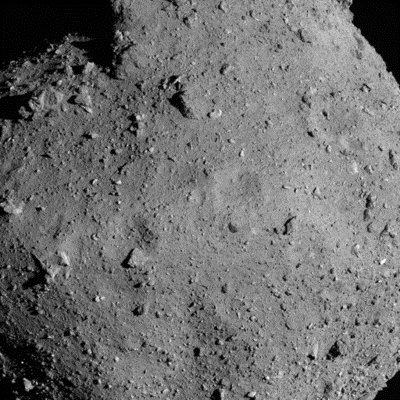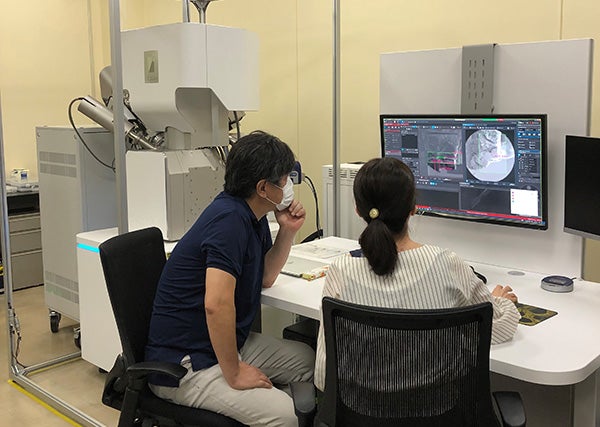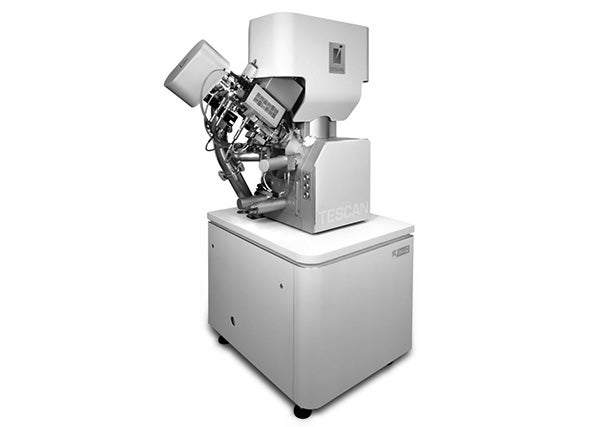Analyzing the samples from Asteroid Ryugu to discover the origin of the Earth and life
TOYO supported Hayabusa2 initial analysis Stone team
(Published on )
Your team is currently working on analysis of the samples brough back from Asteroid Ryugu. Could you tell us about Asteroid Ryugu and why this analysis is important?
First, asteroids are classified into two types: those that contain water and those that do not. In space, due to the low pressure, water exists as either a solid (ice) or gas instead of as liquid. The “snow line” is the boundary where solid water (ice) would evaporate, and it exists far away from the Sun. If the object is formed outside of “snow line” it has solid (ice) and organic matters. Asteroid Ryugu, formed outside of “snow line”, has been considered to be made of sands and ice and to contain water. The collected samples are expected to help us understand the origins of water and life on the Earth.
 “Hayabusa2” shot Asteroid Ryugu(C)JAXA, the University of Tokyo, etc.
“Hayabusa2” shot Asteroid Ryugu(C)JAXA, the University of Tokyo, etc.
Needless to say, there is water on the Earth, but the Earth is mostly made of rocks.
Asteroid Itokawa, from which the first “Hayabusa” brought back its samples, is formed inside of “snow line”, and the analysis project at the time found the beginning of the solar system still remains in the asteroid.
Asteroid Ryugu is a C-type (C comes from Carbonaceous) asteroid formed outside of “snow line” and is believed to contain lots of information about the early phases of the solar system about 4.6 billion years ago.
Could you tell us about “Stone Material Analysis Team”, one of initial analysis teams?
Originally, we had a longer name, but we chose “Stone Material Analysis Team”, or “Team Stone” to make it easier to remember.
Our team has about 150 members in Japan, the US, Germany, and France. We began to analyze the samples in July 2021 at each synchrotron radiation facility that deals with synchrotron radiation generated by accelerating the charged particles. Internal structures and compositions of the materials were examined in non-destructive way. It was also meaningful for this project, unlike the first “Hayabusa”, we could collect enough particles to distribute to each country. In addition, the particles we collected previous time were so-called “dust” and very small, but this time, they were collected in the form of “stone” that we could get a lot of information such as 3D structures which preserved the history of rock formation.
 The sample from Asteroid Ryugu(C)JAXA
The sample from Asteroid Ryugu(C)JAXA
 Dr. Nakamura (left)received the sample(C)JAXA
Dr. Nakamura (left)received the sample(C)JAXA
Even though we call the sample “stone”, the largest one is around 1 centimeter and the most of them are 2 millimeters or smaller in size. We apply such nondestructive analysis as X-ray diffraction (the mineral composition can be identified by beaming X-ray), X-ray CT (X-ray is used to see the inside of objects), Mossbauer spectroscopy (the status of objects’ constituents is investigated), and X-ray absorption fine structure spectroscopy (interatomic distance, coordination numbers, and valences are evaluated by beaming X-ray) to assess the stones’ internal structure and abundance of constituent elements and their distributions.
There are “key materials” or some specific crystals and structures that would help us understand the history of asteroids. First things we should do are to identify, separate, and analyze the materials by using synchrotron radiation X-ray. We, then, precisely extract the identified materials using Xe plasma FIB-SEM (xenon ion beam milling is possible under electron microscope) and slice them with a diamond knife to bring the key materials to the surface.
The most exciting part of this project is to see how we can put together information about the 4.5 billion years of Asteroid Ryugu’s history.
You decided to use Xe plasma FIB-SEM from TOYO to cut the samples. Could you tell us why this system is necessary and important for this analysis?
The stones of “Ryugu” are made up of dust in microns, each of which has various information. While about 90% of the particles are dusts composing “Ryugu”, the remaining 10% have completely different information that is valuable to know the history of “Ryugu”. We need to analyze all this 10% or sometimes 0.1% materials to understand the whole truth of “Ryugu”. Cutting the particles at random is a difficult and inefficient way to find out the 10% materials accurately. Moreover, many of the samples brought back by “Hayabusa2” contain millimeter-order particles. Xe plasma FIB-SEM is the solution to the problem of a traditional way of cutting; it took long time for extracting particles containing important scientific information.
First, we identify the valuable fine particles by seeing inside of particles in nanoscale with synchrotron radiation CT. Then, using Xe plasma FIB-SEM, we target the cross section where the identified particles exist, and slice in nanoscale at high speed with minimum cut. Sometimes, one particle is cut from three points. Xe plasma FIB-SEM is the only system that enables us to cut the valuable samples precisely. We were able to efficiently carry out this initial analysis project which has a limited time frame, and it was meaningful.
 Dr. Nakamura(left) analyzes the samples using Xe plasma FIB-SEM at Keio-TOYO Nano Imaging Center
Dr. Nakamura(left) analyzes the samples using Xe plasma FIB-SEM at Keio-TOYO Nano Imaging Center
 “Xe plasma FIB-SEM” to cut the “Ryugu” particles
“Xe plasma FIB-SEM” to cut the “Ryugu” particles
We look forward to the publication on this initial analysis project. Finally, do you have any message for the children who will carry the future?
I became interested in astronomy at a young age. I got to know that the stars we saw from the Earth was the past, in other words, it was tens of thousands of years away for distant stars and 10 billion years away for discovered galaxies, the Sun is only several minutes away though. This means that observing the astronomical body is to look at the past. I used to go to the beach to look at the stars with an astronomical telescope.
I thought that the only way to study the universe was to look at the stars but learning as a student in university that the universe could be understood through the research on solid materials, I decided to advance in research. “The universe contains the very first materials – the complete record of the beginning” The research I started after hearing the words from my mentor in university is now leading to this initial analysis.
I would like children to understand that there is such an interesting world out there. Doing whatever I want and living my life the way I want, just like Tora-san from Japanese film series “Otoko wa Tsurai yo”, I believe it is worthwhile to give your all to what you like.
 Dr. Tomoki Nakamura
Dr. Tomoki Nakamura
We look forward to the outcome and contribute to developing the space exploration and analysis technologies.






